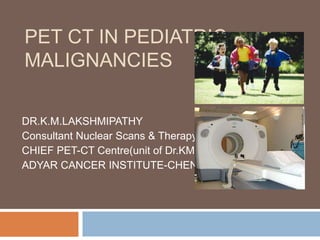Pet ct in pediatric malignancies
- 1. PET CT IN PEDIATRIC MALIGNANCIESDR.K.M.LAKSHMIPATHYConsultant Nuclear Scans & Therapy and CHIEF PET-CT Centre(unit of Dr.KMH)ADYAR CANCER INSTITUTE-CHENNAI
- 2. PET/CT in Pediatric Oncology Treatment and outcome for pediatric malignancy have improved over the years and at least 70% are now curable. Keeping this in view, early diagnosis, staging, restaging and monitoring response to therapy become important in management.
- 3. PET/CT imaging proves golden for detecting cancer in children13. December 2007 02:34PET/CT imaging exhibits significantly higher sensitivity, specificity and accuracy than conventional imaging when it comes to detecting malignant tumors in children, Primary concern ŌĆō Cancer induction from PET/CT and CT imaging Patient benefits from PET/CT and CT imaging will have to be balanced against ŌĆ£the cost of the radiationburden to the individual patient, and possibly to the communityŌĆØUse of radiation in medicine must do more good than harm (i.e., The procedure should improve diagnosis)
- 4. Guidelines for the use of PETŌĆōCT in children Nuclear Medicine Communications 2008, 29:418ŌĆō424Treatment related indicationsBefore local therapy, scans should be considered in: Children who are candidates for radiotherapy (for conditions known to be FDG avid),Hepatoblastoma requiring liver transplant,WilmsŌĆÖ tumour considered for bilateral renal surgery(to assist nephron sparing),Stage 3 neuroblastoma after initial chemotherapy (if further chemotherapy is being considered to further reduce the tumors),
- 5. PET CT uses in pediatric malignanciesMutilating sarcoma surgery.Treatment response scans should be considered in anychild with:HodgkinŌĆÖs lymphoma (as per Euro-NET protocol, for children on and off trial);Non-HodgkinŌĆÖs lymphoma with poor response on conventional imaging;MIBG-negative neuroblastoma;Langerhans cell histiocytosis;Soft tissue sarcoma.
- 6. Indications contdŌĆ”..Residual mass assessment may be appropriate in:HodgkinŌĆÖs lymphoma,Some soft tissue sarcomas,Neuroblastoma.Follow-upScans for follow-up are only advisable if prompt further life-saving treatment is planned in the event of relapse/ progression.Relapse Scans may be considered in any child with confirmed or suspected relapse of above conditions.
- 8. HDL Rx FOLLOW UPEWING ŌĆśs SARCOMA WITH LUNG METS .
- 9. OSTEOSARCOMA RECURRENCE WITH LUNGS METSOSTEOSARCOMA WITH LUNG METS PRE Rx POST Rx
- 10. Preparation for PET CTBefore┬Āthe test, we suggest you talk to your child about what will happen. For young children, use simple words and explain only shortly before the test. Also know we recommend sedation┬Āfor children under age 5. Also before your visit, please: Arrive at least 15 minutes before your child's┬Āscheduled appointment time. Do not allow food, drink (except water) or chewing gum at least┬Āsix hours before your visit - all can interfere with results.┬Ā Do allow the child to drink plenty of water.Dress the child in comfortable clothing, avoiding metal snaps and zippers - all can interfere with results. After arrival, we may suggest the child wear a hospital gown.Keep the child away from┬Āstrenuous physical exercise 24 hours before your visit.For older children, bring a book, DVD or toy to play with while waiting.If on the day of the test, your child feels feverish, please let us know.
- 11. Whole-Body PET/CT Scanning: Estimation of Radiation Dose and Cancer RiskThe total effective dose from each PET/CT study was about five to 13 times the worldwide average effective dose from background radiation over 1 year, which is estimated to be about 2.4 mSvthe effective dose from 18F-FDG PET/CT scanning with a diagnostic CT protocol and an administered FDG activity of 370 MBq was calculated to be up to 32.18 mSv, and the associated lifetime cancer incidence was estimated to be up to 0.514%REF:April 2009 Radiology, 251, 166-174.
- 12. Our team
- 13. Dr .Kamakshi Memorial HospitalCYCLOTRON IGRT
- 14. Thank you













